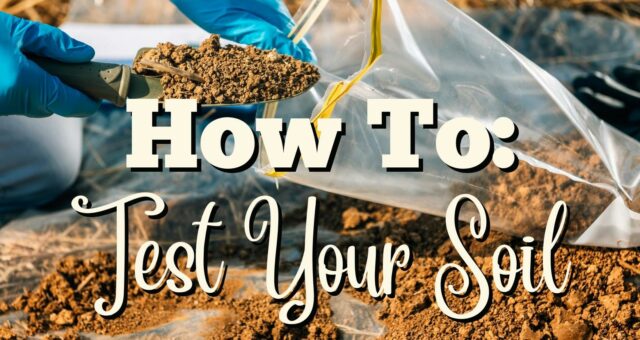
How To Test Your Soil
It’s that time of year again: gardening is around the corner! Before you dig into your garden beds, it’s important to know the soil you’re working with. You will get more out of your garden with healthy soil. Your plants will show more growth and be more fruitful with the right blend of nutrients. Find out the health of your soil today!

The Importance Of Testing Your Soil
Soil is a combination of clay, silt, sand, and organic matter. The balance of this mix can make or break the success of your lawn or garden. This is because different plants thrive with different levels of pH, different levels of water retention, and different percentages of certain key nutrients.
Many plants will actually need different things depending on the time of year. Since plants are so sensitive to the soil they are in, it’s very important to know what is already in your soil before you start adding fertilizers or amendments.
Maryland has recently passed laws regarding lawn fertilizers, in order to help protect the Chesapeake Watershed. There are certain times when you have to test your soil before you are legally allowed to add certain nutrients – this is why it is important to do research before starting your lawn.

Necessity Of A Soil Test Kit
To make a general assessment of your soil’s makeup, you may not need a soil test. You can check the general water retention of your soil, the organic life living in your soil, and the texture of your soil without a test.
To see how many worms are living in your soil, dig a few holes in various areas of your garden, and count the number of worms you find. The more worms you find, the better the indicator of soil health.
To evaluate the specific nutrients and pH in your soil, a test kit is highly recommended. There are home kitchen hacks for pH testing but they are very difficult to master.
We offer a variety of at-home kits that will help you evaluate both the nutrient makeup of your soil and the pH levels. They are a quick way to evaluate what your soil may be lacking.

Collecting Accurate Soil Samples
In order to use a soil test kit, you need to collect an accurate sample of soil. We recommend you do a separate test for each type of area around your home. Lawns, vegetable gardens, flower beds, and shady areas under certain trees will all need to be evaluated separately since they will probably need very different kinds of amendments for your plants to thrive. Here are the steps to get the best possible soil collection:
- Clean your tools. You shouldn’t use tools that have ever been used to scoop fertilizers or amendments because they can leave trace elements even after you clean your trowel or shovel. If you’ve only used the tools for general gardening, simply give them a good clean and dry them well.
- Wear clean gardening gloves, since you should not touch the soil sample. Again, don’t use gloves that you have used to handle fertilizers or amendments with already.
- On a day when your soil is dry, dig 5 – 10 holes in different spots around the area you are testing. Remove any lawn, plants, or weeds from the area of soil you are sampling.
- With a sharp, clean shovel or trowel, take a ½” to 1” wide slice out of the edge of each hole, on the side where you removed the grass. It’s best if this wedge is about 5 – 8 inches long (3” – 5” for lawns).
- Place your sample soil wedges into a clean bucket together.
- Mix up your soil samples well. Again, this is best done when your soil is very dry. You can let the soil dry out in the bucket for a little while if it is still moist.

How To Use A Soil Test Kit
When using an at-home test kit, follow the instructions included. Typically, an at-home test will include a small container for the soil, a capsule with the chemical testing solution, and an eye dropper to add the right amount of water. Using distilled water can help with accuracy.
Then you will match the solution to a color chart after everything has been mixed together, and the color will determine the pH or nutrient percentage.

Estimating Soil Makeup
There is a quick way to assess the general makeup of your soil. Grab a handful of soil that is very slightly moist, and squeeze it in your fist. If your soil:
- balls together into a solid lump, it is likely made up mostly of clay and needs more drainage.
- comes together and then slides apart again into a small puddle in your hand, it is probably made of mostly silt and will need some sand for drainage and some clay for structure.
- crumbles into tiny pieces and doesn’t stick together at all, it is most likely sandy soil and will need some silt and clay to help with retention and structure.
- crumbles like an oreo cookie (“has a nice crumb”) and sticks together just a little bit, it is probably a good loamy soil and is an even mixture of all three types of soil.
You can also fill a hole with water and watch to see how quickly the water drains away. The faster the water empties into the soil, the more sand you have in your soil. The slower it drains, the more clay you probably have.

A Note About Nitrogen:
Nitrogen is integral to the life cycle of both plants in your garden and the microorganisms that benefit your plants, and it is notably very difficult to test. A good way to estimate how much nitrogen you have in your soil, aside from a test, is the health of your leaves and plants.
Plants with yellow, pale leaves and stunted growth could possibly be lacking in nitrogen. Plants that have very dark green leaves, lush growth, leaves with burnt crispy edges, but very little fruit or flowers are probably having an issue with too much nitrogen.

Amending Your Soil
Now, it’s time to fertilize! With your results, you should be able to better understand if your soil needs more acidity (a lower pH), higher alkalinity (higher pH), better drainage, better structure, or more of a key nutrient. Most lawns and garden plants do best in loamy soil with a balanced pH between 6 and 7 (with some exceptions).
Fertilizers are labeled with an NPK number to better help you understand what is in the fertilizer and what you need: N for Nitrogen percentage, P for phosphorus percentage, and K for potassium percentage. ( A “10:10:10 fertilizer” has the same amount of all three for its NPK value, and is a better fertilizer for gardens than it is for lawns).
The University of Delaware website is a great resource that includes lots of information and resources for understanding test results.
If your at-home test says you are low in some elements or high in others, you can use organic methods to balance your garden or you can use fertilizers. Organic ways to add nitrogen are the best method since it is exchanged between organic life so frequently. Mulch, worms, and regular compost are great for a healthy soil ecosystem.
Use the NPK number to find a fertilizer that helps you reach your soil goals, depending on what your plants need. More nitrogen is good for growth but less nitrogen is better for fruits and flowers.
Espoma offers a great range of organic fertilizers and soil amendments for every situation and we carry many of their products. They have an acidifier, lime, bone meal, worm castings, and other products that naturally balance the soil. They also have specific products that are designed for specific goals or plants, taking the guesswork out of the equation.

Shop Our Soil Amendments
Come in and ask our team if you have any questions about testing your soil or the products to use to rebalance your soil. Early spring and fall are the best times to test your soil since both seasons are ideal times to plant in your garden. Stop in today or shop online for your soil and soil amendments!




Your guide on soil testing is a treasure trove for gardeners! The step-by-step instructions and emphasis on understanding soil conditions make it an essential read. Excited to apply these insights in my garden. Thanks for sharing!